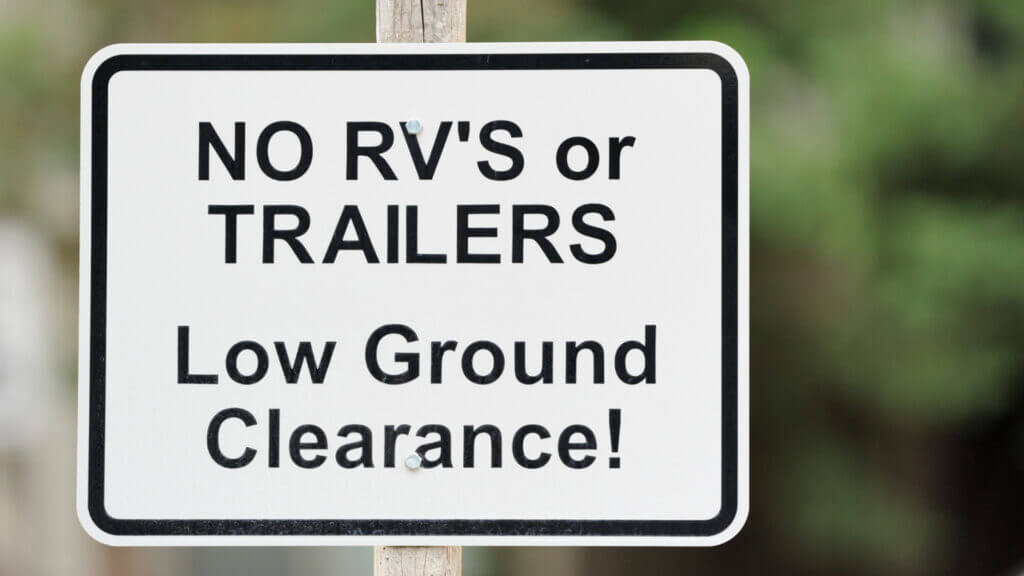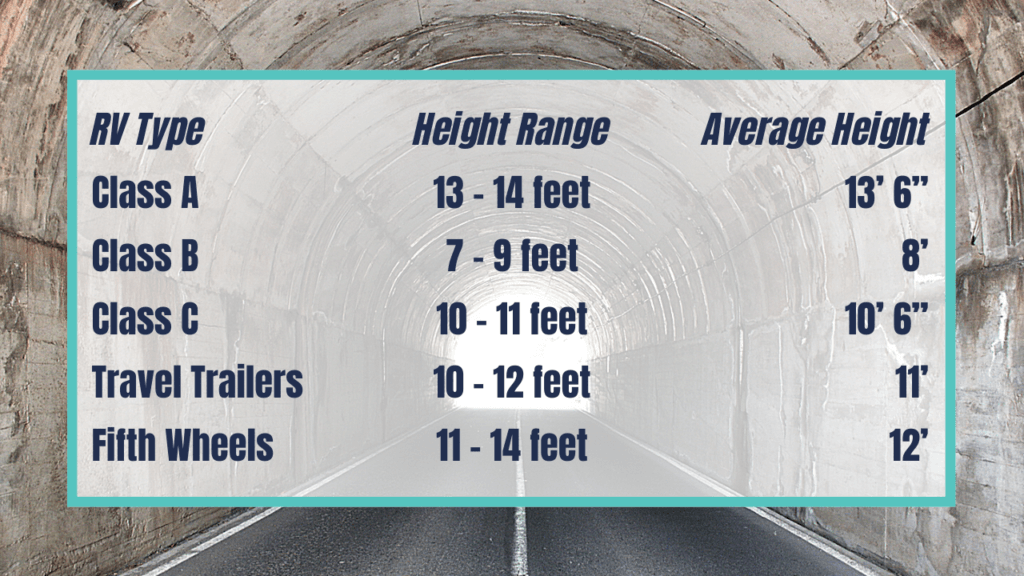Table of Contents Show
When you commit to towing or buying a larger RV, you have a responsibility to learn new rules and motor vehicle laws. These laws include being aware of your height and clearance, among other safety and logistical changes. This knowledge is for your peace of mind, as well as to protect your investment! Nothing ruins a great trip, like causing thousands of dollars of damage to your rig or getting stuck in a difficult or impossible place to get out of without time and stress. Be confident in your driving and know your exact RV height clearance!
One way to check height limits is by reading the State and Federal Vehicle Height Regulations Maximum Allowable Vehicle Height. Most states are 13’6”, except for Kentucky, which is 11’6” tall. Some states have 14’ on their state-maintained roads (freeways). Most states have a 14-16 foot minimum height for bridges and overpasses, but again, better err on the side of caution here, as the size can change 2-3” each time a road is repaved and usually isn’t measured again. Private property may not comply at all with these limits.

RV Specific Clearance Rules
These height limits on vehicles pertain to commercial vehicles, but in many states, RVs aren’t considered commercial, so they don’t apply. Your RV may be above the height clearance! Most likely if aftermarket changes were made. Some states have laws pertaining only to RVs, while other states lump RVs in with commercial vehicles. Be aware of your state rules if you are close to height limits.
Bridge Clearance Issues
Not all routes are big RV safe. Many bridges, especially on smaller rural roads or in town, are not tall enough. You can’t trust the signage either, as signs often aren’t up to date after road repairs, repaving, and erosion. Most bridges started with 14-16’ clearance. This measurement gives you a base guideline for where you will be “safe.” But things can always change based on road conditions, repairs, sagging bridges, or other changes that may not be up to par, especially on smaller roads.
Recommendations for You, the RV Owner
Know How Tall Your RV Is
It is important to measure to the top of all AC units, generators, racks, antennas, satellites, and anything else that is on top of the RV. Your listed height doesn’t typically include rooftop additions such as AC units. Don’t rely on the manufacturer’s numbers or the owner’s manual only. These numbers are not always accurate, depending on wheels, aftermarket accessories, AC units, or additional roof items.
Map out Your Route
Mapping your route is especially important the more you get off the beaten path. The likelihood of low or tight routes increases on smaller roadways. Using an RV specific GPS App is very important if you have a big camper. These apps allow you to input your rig’s size, and it will calculate a safe route.
Pay Attention to Signs
While signs aren’t always reliable, they are your first clue that a road isn’t going to be safe for your rig or that a tight turn, dead-end, bridge, or overpass may be coming up.

Go Slow Under Low Bridges
Just in case you have a tight fit, if you go slowly, you can figure out if you’re going to fit before you do intense damage to your rig. Remember, any damage is your fault. If you damage a structure with your rig, you are liable to fix it and your RV. These repairs can get very costly, very fast. Besides, you are without your RV for a long time.
Don’t Go Through Drive-Thrus!
This should go without saying, but this happens a lot, where drivers forget they are towing or think they will fit. Don’t try to squeeze into banks, fast food, or other drive-thrus with trailers or large RVs. Often the turn is too tight, even if there isn’t a roof. Taking out corners of buildings, landscaping, curbs, and barricades are rough on your rig. Just go inside and be safe.
So, How Tall is an RV?
Just an idea of the range, below are heights for various types of units. Of course, this is just an idea; your rig can vary, and you should be sure to measure it yourself before hitting the road.

When you tow, being safe and getting to your destination with minimum stress is the key to enjoying your new mobile adventure unit. Making sure to get there in one un-damaged piece, with all your rooftop accessories, wheels, and corners unblemished is a great place to start. And no one wants to have to back a rig up a road for miles to a turnaround point either just because you didn’t know your RV’s height clearance! You can avoid this stress by measuring your rig, mapping your route, and using an RV-specific GPS, especially if you are heading off the beaten path.







Jason, my fifth wheel rig measures 13 ft, 4 inches in height. A nearby bridge tunnel cautions a max height of 13′ 6″ which theoretically provides 2 inches of clearance. Would you use the tunnel given the parameters described above?
Yes, but I would do it slowly!
Years ago we did a X-Country trip in a Class A motorhome. We were using AAA Trip Tick’s mapping our route. We did know our height but going to Churchill Downs in Kentucky we saw a low underpass. Blood pressure began to rise. I was able to turn around though. I spotted a beer delivery truck and assumed he might be going there as well and followed him. Saved by Budweiser ! Couple of weeks later we were headed to NYC via the New Jersey Parkway.. Stopped to pay the toll. The person took our $$$ and waived us on. About 1/2 mile in, a sign stating low clearance ahead. I don’t remember the exacts but I felt we were about 3-6″ too tall. There were no exits, and traffic was very light. I straddled two lanes in the center and cleared. I was curious why the toll person didn’t say anything to us; but for the rest of the trip I was very, very cautious.
We recently upgraded from a 28′ travel trailer to a 36′ 5th wheel, which has a height of 13’1″ due to the front air conditioner unit. Our two biggest concerns when making this purchase were, would we be able to secure a large enough site in the national parks we are visiting this summer and our travel route with bridge clearances. Well, for Zion Park, we can’t take the east entrance with this size rig, so we will be using the west entrance. We are coming from the east coast; it adds miles, but the campsite is on the west end and better safe than sorry. We will be taking scenic route 12 to get to Canyonlands and Arches and were deeply concerned about the two arch bridges we need to cross under. We watched several videos of RV’s passing through, noted the height clearance and figure if we go through slow, straddling the middle, we should be ok. It also appears they are building an alternate road by the tunnels, to bypass going through them, right by the bike lane. Hopefully this will be completed before we head out in August, as we would feel much better going around, than under. We’ve also been very fortunate to secure sites in all the national parks we are visiting, but man what a gamble on recreation gov.com!
BTW, your State and Federal Height Regulations link was a godsend. Printed and added to our travel folder.
Thank you!